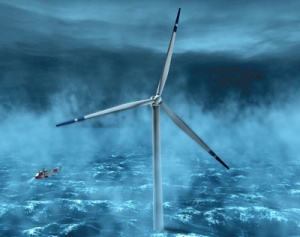Supported by a $300,000 NSF Award, the Work Could Point Toward a Way of Meeting a Substantial Portion of the Energy Needs of Coastal States.
A research team at WPI is studying the feasibility of placing large wind turbines on deep-ocean platforms. Supported by a three-year, $300,000 award from the National Science Foundation, the study combines sophisticated computer simulations and water tank studies using physical models. It may point the way toward an environmentally friendly source of energy that could potentially fill a significant portion of the electricity needs of 26 coastal states.
“For wind to play a significant role in meeting the energy needs of the United States, two considerations must be accounted for,” says David Olinger, PhD, associate professor of mechanical engineering at WPI, who is co-principal investigator on the project along with Gretar Tryggvason, professor and head of WPI’s Mechanical Engineering Department. “The energy must be generated close to where it is needed and it can only be generated where the wind blows steadily. In particular, energy is needed to power cities on the east and west coasts, and the wind blows most steadily off shore.”
In fact, the states with the greatest need for more electricity are those that would benefit the most from increased offshore wind power generation, says the U.S. Department of Energy (DOE). Of the contiguous 48 states, 28 have coastlines; according to a 2008 DOE report, those states use nearly 80 percent of the nation’s electricity.
Yet only six of those states “have sufficient land-based wind energy resources to meet more than 20 percent of their electric requirements through wind power,” the DOE report notes. “If shallow water offshore potential (less than 30 meters depth) is included in the wind resource mix, 26 of the 28 states would have the wind resources to meet at least 20 percent of their electric needs, with many states having sufficient offshore wind resources to meet 100 percent of needs.”
Watch videos about other wind-power research underway at WPI on generating electricity with kites, using wind turbines to clean the electric power supply, and making more durable gears for wind turbines.
Europe, which has been steadily developing its wind power potential for over a decade, currently boasts more than 5,000 wind turbines that generate over 65 gigawatts of power annually. Many of those turbines are offshore, and more are being built all the time. In fact, the United Kingdom proposes to have enough offshore turbines by 2020 to power every home in the nation.
All of Europe’s offshore turbines are currently mounted on fixed-bottom, foundation-based towers in shallow water, not more than 130 feet deep. But the world’s first deep-water, floating turbine, capable of generating 2.3 megawatts of electricity, is currently being tested off the coast of Norway and expected to come online soon.
Despite its more than 12,000 miles of coastline, the United States has lagged far behind Europe. Indeed, the Cape Wind Project, which would install 170 turbines in shallow water off Cape Cod, would be the first American offshore wind farm. But its development has been stalled principally by concern that the turbines, which would be visible from shore, will despoil the natural beauty of the cape’s coastline.
“Floating wind turbines, located far from land, would solve the environmental and aesthetic concerns associated with placing turbines near attractive natural beaches and coastal environments,” says Olinger. “They would be essentially invisible from shore while also being located in areas that provide greater wind power potential. Large sea areas, with stronger and steadier winds, are available for wind farm development.”
Olinger’s research is assessing the potential for developing offshore wind farms consisting of up to 100 floating turbines each capable of generating five megawatts of electricity (more than 60 percent larger than typical land-based turbines), or enough to power up to 500,000 typical homes. While the potential is immense, the obstacles associated with placing turbines weighing up to 15 million pounds atop towers as tall as 300 feet in deep ocean waters are significant, he notes.
“Before deep water turbines can be developed and successfully deployed, a host of questions must be answered so that they can be appropriately designed,” says Olinger. “How should they be transported to installation sites? What combination of platform and buoy designs, together with mooring solutions, will best stand up to major storms and large wave heights? How will environmental conditions vary from one ocean site to another?”
To address these and other questions, Olinger and his team are combining computer simulations with experimental modeling. “While computational modeling does a good job of handling forces associated with moderate waves and wind, nonlinear responses that will arise in storm conditions require physical modeling,” he noted.
For that, the WPI team is exposing scale models of deep-ocean platforms to simulated environmental conditions in the water flume test facilities at the historic Alden Research Laboratory in nearby Holden, Mass. Founded by George I. Alden, WPI’s first professor of mechanical engineering, this is the nation’s oldest continuously operating hydraulic lab. “The Alden facilities allow us to identify unexpected conditions and the need for alternate design modifications early in development,” says Olinger. “That means significant savings of costly changes further down the road.”
Already, the team has examined towing and transportation conditions. The impact of severe wave conditions on the scale models will be tested later. When the entire project is complete, Olinger aims to have a computer simulation program capable of testing a wide range of design types and potential environmental conditions. “Our work is fundamental,” he says. “If deep water wind power is to play a significant role in helping in the U.S. achieve its goal of generating 20 percent of energy from wind by 2030, the knowledge we are creating will be essential.”












